Archie Peace
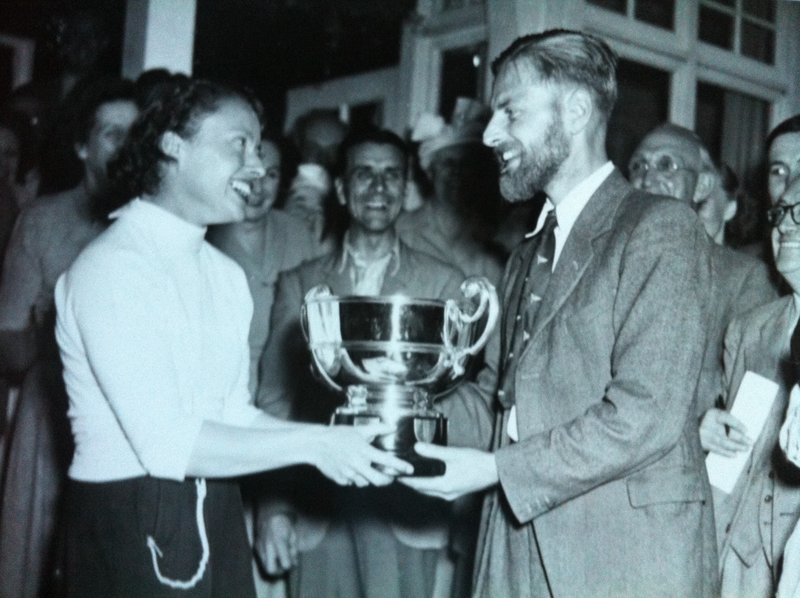
History of albatross marine
Archie Peace

Honourable Peter Hives

One of Britain’s best loved sportsboat marques came into existence only as part of a chance wartime posting.
From 1943 until 1945, the Honourable Peter Hives, the son of Rolls-Royce Chairman Lord Hives and a qualified engineer in his own right, was on the books of HMS Saker, a chain of Fleet Air Arms training stations in North America.
In June 1944 Archie Peace, an Acting Temporary Lieutenant with a BSc in stress engineering, arrived at the same station. Although Peace was there only four months, there was time enough for them to strike up a friendship. They were later to form a boatbuilding partnership comparable in organization with that of Messrs Rolls and Royce, with Hives looking after the production side while Peace exercised his design skills. Their sportsboats are now much sort-after and much-cherished aristocrats in their field.
Following demobilisation at the end of World War Two, the two men decided to establish a boatbuilding concern near the small Norfolk town of St Olaves, near Great Yarmouth. They roughed it at first, living in an old shed and eating fish and chips for supper, working on experimental light-metal hydroplanes, Corsair a 12 foot prop rider powered by an E 93 a that would do 40 MPH . And Symphony a 15 foot hydro also designed by Peace and powered by A pre war Lea Frances formula 1 engine. She was built for the chairman of Norwich city football club.
Corsair

Symphony
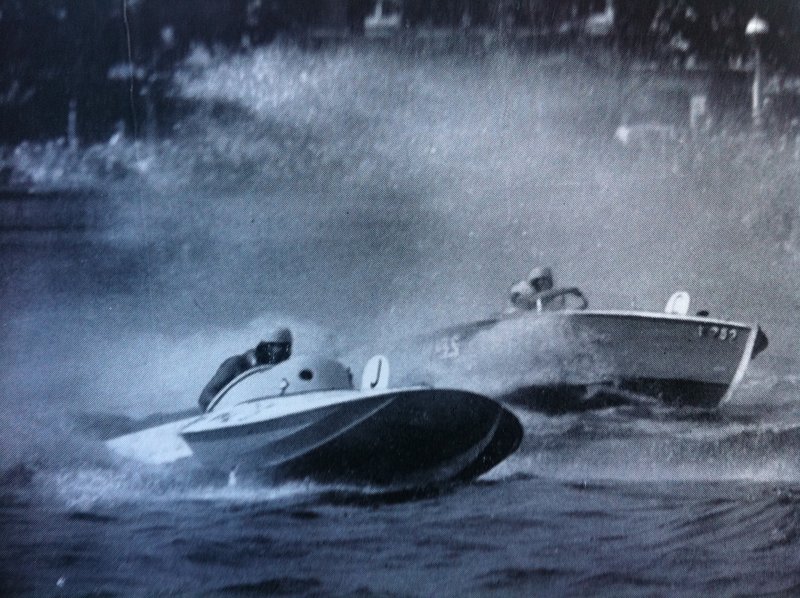
In late 1949, when they came to set up a proper company, news came from the USA of an amphibian aircraft which had just gone into production by Grumman, designed the SA-16A but know as the ‘Albatross’. With fond memories of their time in America, Hives and Peace decided Albatross Marine would be a good name for their fledgling company, and for the two-seater aluminium craft which Peace had just designed using aircraft principles.
The key to construction of the Albatross sportsboat was the way in which Peace decided to have the riveting process done in reverse. Normally you hammer the tail end and hold the dolly on the countersunk end; he found out from bitter experience that this system would not seal, so he did it the other way round.
In 1950 still not sure of which way the company should go they tried their hand at a river cruiser Beaver Bell. With three cabins and powered by an E93 a she was to remain a one off but still survives today.
Beaver
Bell

By late 1950, Albatross Marine had built a two-seater prototype with a length of 12ft 9in (3.9m), a beam of 4ft 7in (1.4m) and 1ft 6in (0.5m) draught, weighing just 160lb (72kg). It was powered by a Ford Anglia E93A side-valve engine putting out 26-27hp. Peace did his own conversion, designing a complex thrust to take the drive from the front cover end of the engine.
Proto type

Hives and Peace consulted some marketing experts, only to be told that that they were wasting their time and that the Albatross was a ‘no-goer’. But, being a very stubborn man, Archie pressed on, taking on work for other clients to keep going.
In 1952 ‘Toby’ Sutton, a wealthy member of the Oulton Broad Motorboat Club, had the Albatross workforce coach build in aluminium the 17ft (5.2m) Ventnor three-point prop-rider. Fitted with a six-cylinder Wayne Chevrolet engine developing 210hp at 4800rpm, and 70 mph, Rooster was unbeatable in races on Oulton Broad for the next two season
Rooster

Using the finance brought in by such ventures Albatross Marine went into production with its first batch of MkI two-seaters, fitted with the famous Ford E93 a engine, and priced at £500.
Mk 1
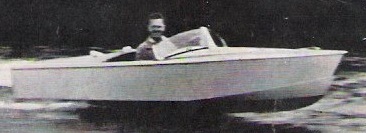
In 1952 the company took on a third partner. Bruce Campbell had married the chairman's daughter Hoover , and had a 100ft (30m) steel yacht called Christina, and was something of a playboy. He cruised the Mediterranean to promote the Albatross. His trick was to more in one off the bays in the south of France and then drive around the big yachts until he was call over to show off the boat , were upon he would sell the boat to them.
Bruce Campbell
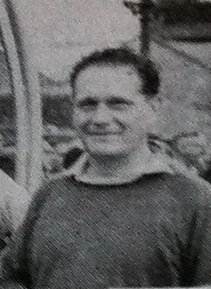
But he was successful in spreading the word. Most Albatrosses were soon going to the big yacht owners in the Med. Everybody who was anybody wanted one. Customers included Brigitte Bardot, Aristotle Onassis, Prince Rainier of Monaco, Grace Kelly, George Formby,Prince Phillip, actor Jon Pertwee and the Prince of Greece.
Prince Rainier and Grace Kelly with albatross boats in the back ground

In 1955 the Aluminium Development Association presented one to the Duke of Edinburgh. Painted to match the colour of the Royal Yacht HMY Britannia, on which it was carried, its engine was so highly polished that it positively gleamed.

As well as selling A lot of boats to Europe albatross were successful at finding new markets else were in the world. Boats were sent to as far away as New Zealand Sarawak and the USA.
The only Continental to be
imported in the day to Lake Okatina, New
Zealand

The Albatross became popular as the waterskier’s workhorse, as David Nations, the trainer of two world champions, related in his ‘Guinness Guide to Waterskiing’
“In 1952 I had a phone call from Bruce Campbell, inviting me down to Great Yarmouth to see this boat. I took Marc Flachard of France, the reigning European Champion then at Ruislip, to ski as my guest. Flachard looked at this boat and exclaimed, ‘Shoosh! I will pull it from the water, David! So Bruce Campbell said , ‘I’ll tell you what, it will pull two of you up together.’ So we took a double tow and sat there, and damn me, it bloody well pulled the both of us up. So I bought one for Ruislip Lido.
“It was a brand new machine, which still had its teething troubles. They were to base all their modifications on our work. For example, during the water-testing, we would get evaporation, the boat would go for 100 yards and then stop. We found out that the Carburettor was so near the heat manifolds that the petrol would vaporise. We were telling them all the problems by phone and they were modifying it back at their yard, such as lowering the seating and coming up with a new design of rudder for improved manoeuvring. "Later on, I bought another Albatross, because they were ideal boats for teaching. "
Albatross had not restricted themselves to small boats. In 1953, Peace had designed aluminium 42ft (12.8m) craft called Gay Jane, which was sent to America. Then he did four 25ft (7.7m) sportscruisers, based on a scaled-down motor torpedo boat (MTB), surmounted by a weird flybridge with a deflector on the top.
Gay
Jane
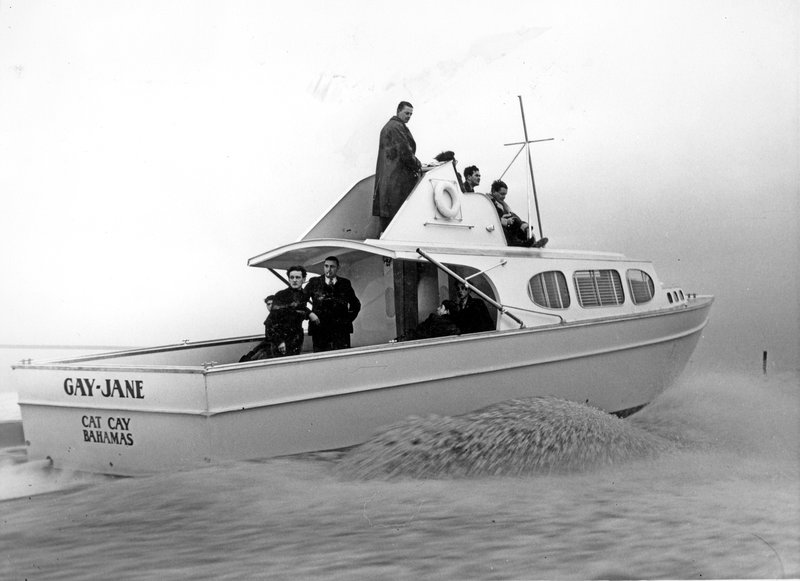
The first of these was powered by twin 100Es, each with its own drive, typically engineered by Peace to the thousandth of an inch. The second had twin Perkins 99s, whilst the last two had 1500 fords.
Diesel Cruiser

By the end of 1954, the company had another bigger shed built to deal with increased demand . Business later grew to the point where at its peak, Albatross Marine employed 60 people, turning out 150 boats per year. British Rail even built a special siding for the firm at Little St Olaves station, from where box-cars loaded with five two-seaters each could start their journey to the South of France or Italy.
Demand grew for a four-seater, so in 1957 Peace scaled down the sportscruiser to create the 15ft 3in single-engined Continental. Sales took off.
First
Continental

Peace’s favourite saying was that there was no substitute for capacity, and in 1955 Albatross started to install the More powerful 1097cc overhead valve four-cylinder Coventry Climax engine into their hulls.
“We took the first four-seater with the Climax into Loch Earn in Perthshire,” Wright remembers. “The Lochearnhead Hotel was owned by Ewan Cameron, a former Scottish Highland Games heavyweight champion, standing 6ft 4in and weighing 22 stone. Until then, it had taken two Albatrosses to get him up on water-skis. Now it took one continental.
“We quickly went over to the 1220 engine when it became available. It was a revelation. It was all Aluminium, very light, and in standard form gave about 70bhp. We had ‘stage two’ with the twin carburettors, which pushed it up to about 90bhp, then if you went the whole hog, with high-lift cam, gas-flowed heads, fettled ports and so on, you squeezed just over 100bhp from it. We raced the A series two-seater with great success. It used to do about 54mph.
More power started to bring racing successes for the Albatross boats.
In 1955, the royal Motor Yacht Club hosted the Lady Brecknock Trophy race at Poole. Five of the 11 competitors drove Albatrosses. First, second and third places were gained by Peace, Campbell and Hives. Later that year a Frenchman named Mallet, driving an Albatross Super Sports, won the premier award in the Grand Prix de France d’Endurance, better known as ‘Les Six Hures de Paris’
Wright and Foreman Jack Wilkinson entered an Albatross in the same event several years later. “We were leading for about three hours but then the bolt retaining the rudder quadrant sheered off” says Wright. “We ended up about sixth”.
Paris six hour

That was no mean achievement, because the event was a notorious boat breaker. Some 80 had started, but only 20 finished. “I can distinctly remember the wreckage. Most of the boats then were wooden, and they were self-destructing like matchboxes. There were drivers and cranes everywhere. We were racing through tow-ropes and between barges”.
As they became available, 1100, 1300 and eventually 1500 Ford Cortina motors, were used to power the ever-popular two-seaters, from the late 1950s onwards.
There were also limited editions, such as the Corsair and slipper (with a Roots engine) of which less than a half a dozen were built, and the twin cockpit slipper-stern model Twenty one (a lengthened Continental with a twin-carb Sunbeam Rapier engine) dating from the late 1950s and early 1960s.
Slipper Stern

The A series was conceived in 1959, 13ft (1m) long with a beam of 4ft 10in (1.5m) and 1ft 6in (0.5m) draught. Albatross tried different methods of design than before. Instead of developing the hull from cylinders, we did it from cones. It worked well because we got a better shape. We had the first prototype on the water by January 1960, and were racing it locally that year.
A series

“Archie always believed in local racing, purely for improving the breed. He reckoned you could get about five years ‘of normal use into a season’s racing, and show up the weak parts. “
Tragically, in 1957 Archie Peace had contracted multiple sclerosis, at the age of 40. And following this Bruce Campbell and Peter Hives after a disagreement between the three left the firm.
MS is relentless, and his health deteriorated rapidly. He couldn’t see very well. He couldn’t walk. Injections bucked him up every now and again and, being stubborn, he still had ambitions for Albatross. He was always experimenting.
His unsuccessful last-ditch attempt was a MkV, in GRP. There was an 18-footer on the drawing board, to be powered by a 4.2lt Jaguar engine, which would have caused quite a stir. But eventually Peace had to give up, and the firm closed down in about 1966. His death in 1969 was not widely reported in the press.
Present day
In 2009 John Fildes bought an A series, not really knowing what he had let himself in for.

After much research, and traveling the length and breadth of the country to find out all he could about Albatross, John was finally able to launch his boat in 2010.
Duncan Peace and John enjoy a moment of rest between races

Having enjoyed the experience, he bought another A series climax in November 2011, and set about restoring her. In the New Year, by chance, he met Archie’s sons who then went on to be the new owners of the boat.
After much discussion it was decided to re start Albatross Marine to try and help keep these great boats alive.
Duncan racing hard at Oulton Broad 2013
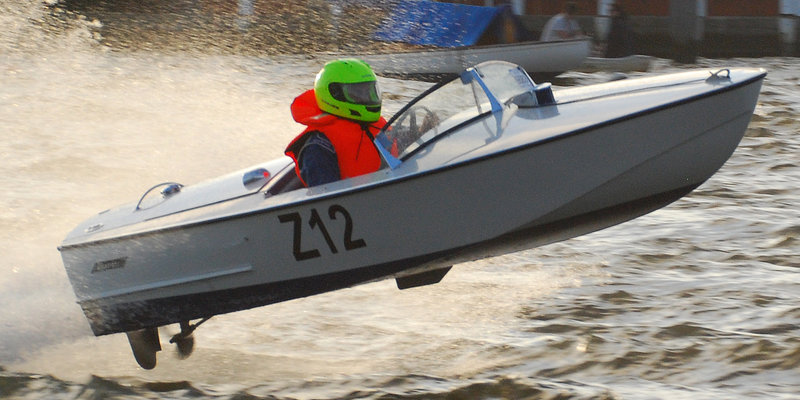
Today there are annual Albatross rallies and races for all, with the hope to keep building their profile and growing the circuit. If you like the look of it, come and join us and enjoy the fun!